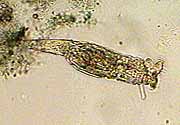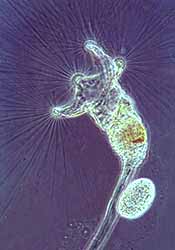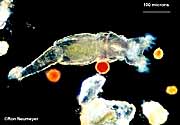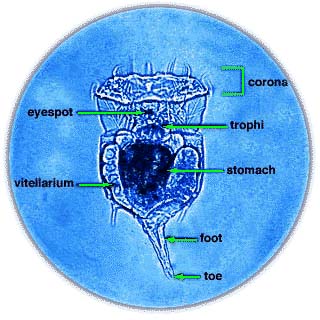 |
 |
 |
Rotifers are microscopic aquatic animals of the phylum Rotifera. Rotifers can be found in many freshwater environments and in moist soil, where they inhabit the thin films of water that are formed around soil particles. The habitat of rotifers may include still water environments, such as lake bottoms, as well as flowing water environments, such as rivers or streams. Rotifers are also commonly found on mosses and lichens growing on tree trunks and rocks, in rain gutters and puddles, in soil or leaf litter, on mushrooms growing near dead trees, in tanks of sewage treatment plants, and even on freshwater crustaceans and aquatic insect larvae. (Örstan, 1999)
Because of their very small size and mostly soft bodies, rotifers are not commonly favored for fossilization. Their only hard parts, their jaws, might be preserved in the fossil record, but their tiny size makes detection a serious challenge (Örstan, 1999). However, fossils of the species Habrotrocha angusticollis have been found in 6000 year old Pleistocene peat deposits of Ontario, Canada (Warner et al., 1988). The oldest reported fossil rotifers have been found in Dominican amber dating to the Eocene (Waggoner & Poinar, 1993).
 |
 |
 |
Rotifers : The rotifers are microscopic animals, and under high magnification will look something like the picture at upper left, for most perople using a light microscope. Those with more sophisticated microscopes and lighting techniques can give rotifers such as Philodina, grazing at lower left, a beautiful glow. At right, Collotheca is another monogonont rotifer, shown here bearing an egg on its stalk end. Notice the extemely long coronal cilia this rotifer uses to catch food. (Click on any of the pictures above for a larger image).
Rotifers are multicellular animals with body cavities that are partially lined by mesoderm. These organisms have specialized organ systems and a complete digestive tract that includes both a mouth and anus. Since these characteristics are all uniquely animal characteristics, rotifers are recognized as animals, even though they are microscopic. Most species of rotifers are about 200 to 500 micrometers long. However a few species, such as Rotaria neptunia may be longer than a millimeter (Orstan 1999). Rotifers are thus multicellular creatures who make make their living at the scale of unicellular protists.

|
The name "rotifer" is derived from the Latin word meaning "wheel-bearer";
this makes reference to the crown of cilia around the mouth of the
rotifer. The rapid movement of the cilia in some species makes them appear
to whirl like a wheel.
At left, you can see a photomicrograph identifying basic anatomical features of Epiphanes brachionus. The general body plan of a rotifer consists of four basic regions: head, neck, trunk (body), and the foot. In most species, the head carries a corona (crown) of cilia that draws a vortex of water into the mouth, which the rotifer sifts for food. The food itself is ground by the trophi (jaws), located just behind the mouth in the pharynx (throat). Trophi are found in almost all rotifers, and are characteristic organs of the phylum Rotifera. The body of the rotifer is externally but not internally segmented. The body is telescopic, with a semi-flexible, extendible, transparent cuticle covering. It is the cuticle that suggests rotifers are close relatives of roundworms and arthropods. Within the body are the stomach and reproductive organs. The final region of the rotifer body is the foot; this foot ends in a "toe" containing a cement gland with which the rotifer may attach itself to objects in the water and sift food at its leisure. |
As well as their morphology and feeding habits, reproduction in rotifers is rather unusual. Several types of reproduction have been observed in rotifers. Some species consist only of females that producetheir daughters from unfertilized eggs, a type of reproduction called parthenogenesis. In other words, these parthenogenic species can develop from an unfertilized egg, asexually. Other species produce two kinds of eggs that develop by parthenogenesis: one kind forms females and the other kind develops into degenerate males that cannot even feed themselves (sexual dimorphism). These individuals copulate resulting in a fertilized egg developing within the rotifer. The males survive long enough to produce sperm that fertilize eggs, which then form resistant zygotes that can survive if the local water supply should dry up. The eggs are released and hatch in the water. If the egg develops in the summer, the egg may remain attached to the posterior end of the rotifer until hatching.
A particular class of rotifers called bdelloids can be found living in almost all freshwater environments, and occasionally in brackish and marine waters. Bdelloids are known for their remarkable ability to survive drying through a process known as cryptobiosis. Factors determining the duration of time that a rotifer is able to withstand desiccation include the humidity and temperature at which they are kept. Ideally, more humid conditions and mild to warm temperatures prevent the very dry conditions that are unfavorable to rotifers. Rotifer eggs can also withstand drying, with older embryos having a greater chance at survival (Örstan, 1999). The species Brachonius calyciflorus has been found to conserve energy when food is scarce by decreasing its respiration rate, while other species show no change in respiration rate. It is predicted that the ability of some rotifer species to adapt to resources with temporal variation in availability allows the coexistence of competing species of rotifers. Therefore, there is a tradeoff between the competitive ability of rotifers and the maximum population growth rate for a particular species. (Kirk, 1999).
Phylum Rotifera is divided into three classes: Monogononta, Bdelloidea, and Seisonidea. The largest group is the Monogononta, with about 1500 species, followed by the Bdelloidea, with about 350 species. There are only two known species of Seisonidea, which is usually regarded as the most "primitive", and in morphological analyses it comes out in a basal position (see cladogram at right).
Observing rotifers is relatively uncomplicated with the correct procedure and equipment. When extracting rotifers from a sample, it is best to use a pipette, drawing water from the area around clumps of soil or plant matter in the sample. The sample should be quickly transferred to a slide so the rotifers do not adhere to the sides of the pipette. Additionally, cover-slips should not be used under a light microscope because rotifers are easily disturbed and may contract into an indiscernible ball. If food is added to the slide, rotifers can be observed swimming if they do not become stuck to the slide (Ricci, 1999). Thus, although rotifers are invisible to the naked eye, they can easily be watched in their exported natural environments with the help of a microscope.
For more information about Rotifera:
 Visit Microscopy UK for a wealth of wonderful rotifer images and information, including:
Visit Microscopy UK for a wealth of wonderful rotifer images and information, including:

Sources:

